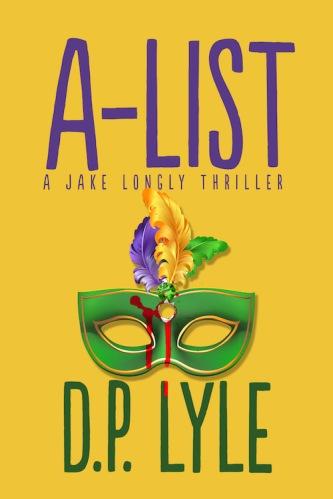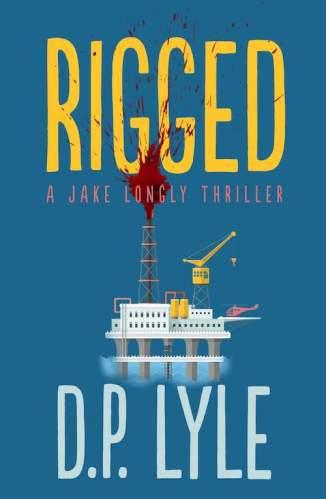Location, location, location.
True in real estate, true in storytelling. Where you set your story dictates everything. The area's geography, weather, and local populace, will alter buildings, businesses, traffic, and the sophistication of police and medical services, as well as the dress, occupations, leisure activities, and, perhaps most importantly, the dialog and speech patterns of the characters. And so many other aspects of your story.
Can you image The Godfather being anywhere but New York? Jaws not being in a beach town? Or the Star Wars ' characters running, or flying, around anywhere but deep space?
In case you don't already know Jake Longly, let me introduce him. Jake's an ex-professional baseball pitcher who now owns Captain Rocky's, his bar/restaurant on the sand in Gulf Shores, Alabama. His life goals are running his bar, hanging out with friends, and chasing bikinis. Well, until Nicole came along. For Jake, life is good. He's content.
Ray, his father, who has a murky military history, feels otherwise. He simply doesn't understand why Jake won't work for him. A real job is Ray's take. Jake believes that running Captain Rocky's is as real as a job needs to be. I mean, he has to show up most days. Isn't that the definition of a job?
Though Jake fights to avoid entering Ray's world, he constantly finds himself exactly there. To further complicate things, Jake isn't well-suited for the P.I. life and not all that good at it. In each story, things quickly get quirky. Therein lies the comedy.
But these unsolicited adventures repeatedly lead Jake far from his home and bar in Gulf Shores. Only DEEP SIX occurred in and around his home, while A-LIST took him to New Orleans.

In SUNSHINE STATE I created an imaginary town in Florida's panhandle, while RIGGED is set the very real and wonderful town of Fairhope, on Mobile Bay.

From RIGGED:
Fairhope, Alabama is considered the jewel of Mobile Bay. Seated on the east side, facing west, its water-reflected sunsets are spectacular. The permanent population is around twenty thousand, but the tourists who roam the streets each year dwarf that. Downtown is small, quaint, artsy, and loaded with fun coffee shops and restaurants. To the north is the equally quaint town of Daphne and to the south Point Clear, home to another bayside jewel, the Grand Hotel. Only thirty miles separates Fairhope from Gulf Shores. But, getting there could take anywhere from forty minutes to an hour and half. Such is Gulf Coast summertime traffic. Probably why I hadn't been there in years though that seemed like a flimsy excuse. Nicole had never seen the town.
And now comes THE OC, which brings Jake, Nicole, Ray, and Pancake to the Left Coast.
Though Nicole spends most of her time on the Gulf Coast, she owns a condo in Newport Beach, specifically on Balboa Peninsula in Cannery Village. In the story, Jake and Nicole travel there for a few days of fun before the filming of Nicole's screenplay kicks off in LA. Under the tutelage of her uncle Charles Balfour, an a-list producer. The area offers settings that infuse the story with the cash and glamor of Orange County (The OC), and SoCal in general.
Some locations are real, others imagined. Rothschilds Restaurant is real, and probably the best restaurant in Orange County. So is The Cannery, an old canning company turned bar/restaurant. Once funky and cool, now upscale and cool. It was once the local drinking hole favored by Dick Dale, the creator of surf music, who lived on the peninsula. The Blue Water Grill sits on the water in Newport Harbor only a lob wedge away. Charlie's Chili has been around longer than anyone can remember. It holds a prime location at the foot of Newport Pier. The chili cheese omelet, Nicole's favorite, is indeed a featured menu item. Locals and tourists pack Charlie's old-school booths for breakfast and really all day.
The condo project where Nicole lives does exist, but with a few story alterations.
I did, then dressed, and walked out on the deck while Nicole made her calls. Her condo, top floor, the third, in a fairly large cluster, hung along a narrow boardwalk and looked down on a line of Newport Harbor boat slips. The late-day sun glinted the water and cast long mast shadows over its surface. Down a few slips a couple seemed to be prepping their sailboat for a sunset cruise. Popular around here. The guy lifted a blue cooler over the gunwale and settled it on the stern seat. That reminded me I was hungry. Made me wonder what the boaters had on the menu. Sandwiches and beer would be fine with me but I suspected Nicole would have wanted lobster, some sort of cheese I couldn't pronounce-Frenchy and nasty-tasting-and Champagne. Toss in some Avacado and quinoa and it would be like so California. Not that Nicole was all that high-maintenance, actually far from it, but out on the ocean in a cool-looking sailboat, she'd likely want to climb up the cuisine food chain. Well before five, Nicole was all spiffed up and ready to go. Didn't take long because she didn't need much spiffing. Took all of three minutes to walk to The Cannery, a Newport Beach institution. It was an old fish canning facility built a century ago that nearly fifty years ago evolved into a popular restaurant/bar. Even had its own boat slips so folks could sail or motor up and have lunch, dinner, drinks, whatever.The Ortega Highway plays a critical role in the story. It's a nasty, narrow, treacherous two-lane black top, always in various stages of disrepair, that connects San Juan Capistrano with the Lake Elsinore area. Known as one of the most dangerous roads in the country, people roll along its twisting and tilted surface at break-neck speed. Particularly motorcyclists who use it to test their machines and skills. Often with catastrophic results. Wrecked vehicles can be found in many of the Ortega's deep ravines.
I top-gunned it through the broad sweep of the connecting ramp and onto I-5. Once I merged, I accelerated to eight-five. Which basically matched the rest of the traffic. Speed limits on California freeways were similar to stop signs in Italy-merely suggestions. Fifteen minutes later-seemed much longer-I could sense Nicole willing the Rover to go faster-we reached the exit to Highway 74, the Ortega Highway. To the right was downtown San Juan Capistrano and the famous San Juan Mission, where the swallows returned every year. Sort of. They had been a bit sparse in recent years from what I had read. I turned left. Two miles later the traffic and signs of civilization faded and the road became narrow and serpentine. The Ortega Highway was one of the most dangerous roads in California, actually the nation. Once you left the residents of San Juan Capistrano behind, the highway-that was being generous-narrowed to a two-line blacktop. It rose, fell, twisted, and tilted through scrub brush-covered hills with rocky hillocks and often deep ravines on either side. Fatal accidents, head-ons, and tumbles down hillsides weren't rare. Add the fact that people liked to test their driving skills as if it was Le Mans, and dudes hurled rocket bikes along the road like it was a video game, often reaching triple digit speeds. To me, it also looked a good area to dump a body. "Take the next right," Pancake said. The road, also a generous description, was called Tenaja Truck Trail. An apt name as it looked more like a trail than a road and a truck was definitely the vehicle of choice. Ratty, rutted, and poorly maintained it wound up hill, then down, then back up, and so on. I was getting motion sickness.Some story locations are total fabrications. Megan's TV studio and her condo in Costa Mesa, Uncle Charles's gazillion-dollar home in the Malibu Colony, which definitely exists, are creations. But not out of place. Each were created to fit the reality of the locale.
The point is that story creates setting and setting creates story. The two must be in lock step. If the author isn't true to the location, credibility is lost and the reader's willing suspension of disbelief evaporates.
The setting can serve as a powerful counterpoint to certain characters. To say that Jake isn't a "Hollywood guy" is much more than an understatement. He doesn't get the purpose of the glam and self-absorption. So when he and Nicole attend a pre-production party at Uncle Charles' Malibu Colony home, Jake must swim among the Hollywood elites who are constantly glad-handing and making deals. Oh, and looking beautiful. Not a comfort zone for Jake, but he manages to navigate it for the most part. But, it's a case where setting can create character tension and discomfort.
In short, where you decide to place your story will alter everything--character, plot, dialog, everything. Choose wisely.
Original Post on Kings River Life: https://kingsriverlife.com/10/27/jake-gets-around/
All Five Jake Longly Comedic Thrillers are Kindle Monthly Deals for November. Only $1.99 each.
https://writersforensicsblog.wordpress.com/2021/11/01/all-5-jake-longly-comedic-thrillers-are-kindle-monthly-deals-for-november/
